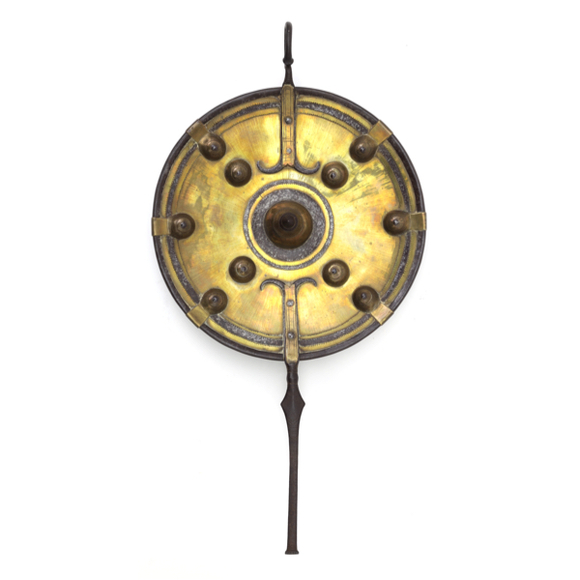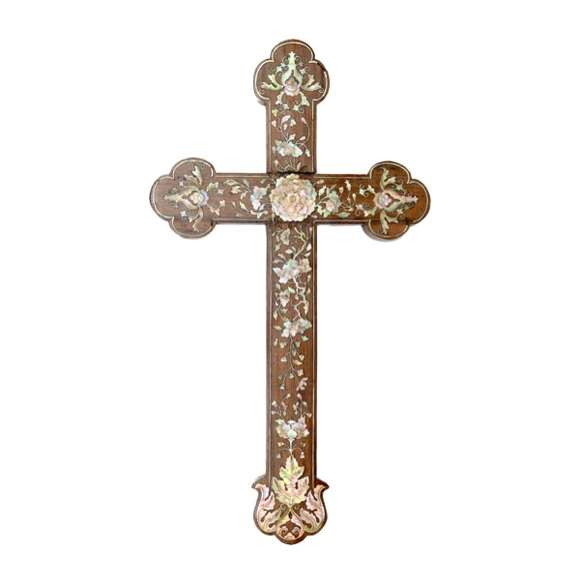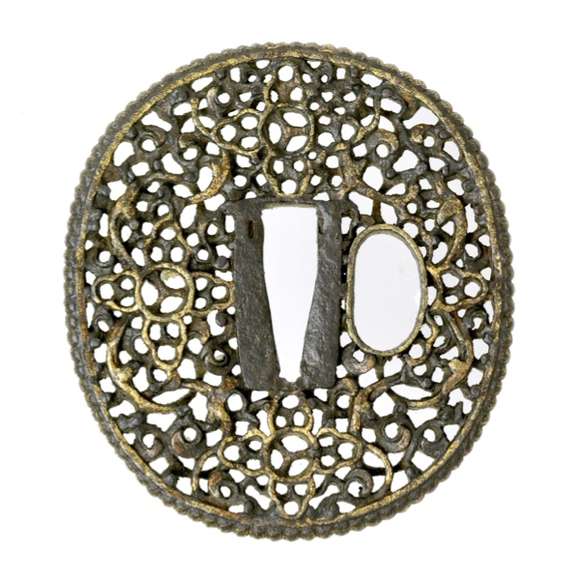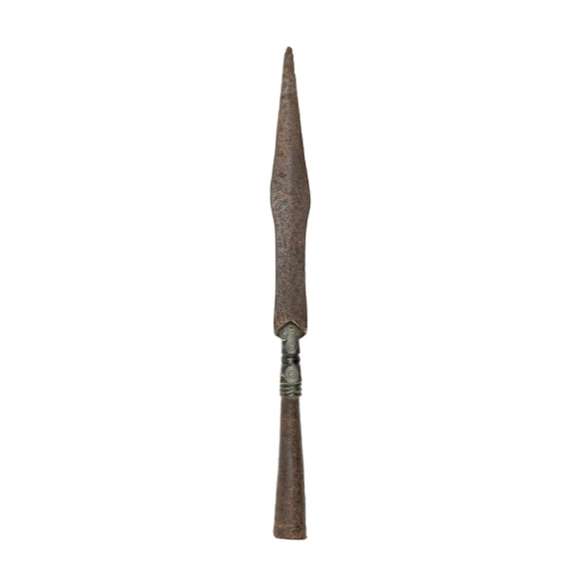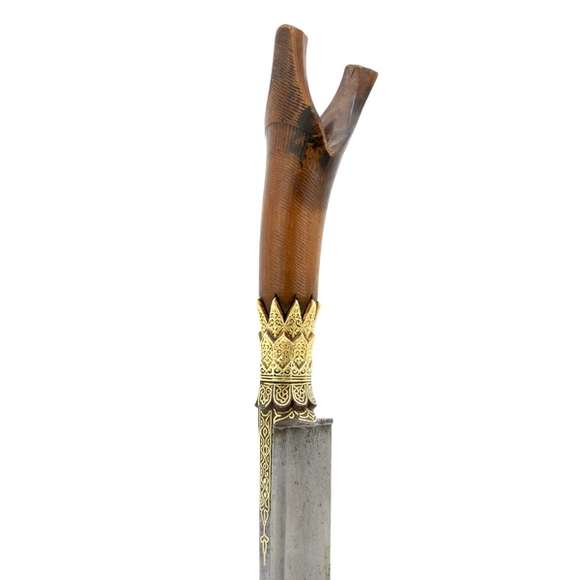Introduction
At its height in the 18th century, the Qing dynasty ruled over a vast territory. There was great cultural and geographical diversity within the realm and so naturally, there were considerable differences in the design, construction, and use of arms and armor throughout the empire as well.
This lack of standardization became problematic for military planning of larger campaigns when for example a thousand spears ordered for the frontier battles differed in construction, size, and cost depending on where they were made.
By the late 18th century, the Qianlong court started to bring back the large variety of arms to a smaller number of standardized styles. They published regulations on the use of materials and production of each of them.1
One of these texts is the Qīndìng Gōngbù Jūnqì Zélì (欽定工部軍器則例) or "Imperially Commissioned Regulations and Precedents of Military Equipment for the Board of Works" of the 13th year of Jiaqing, 1808. It was written for the Board of Works, one of the six ministries under the Qing, which was responsible for public works, infrastructure, and the production of government equipment, among others the arms for the Green Standard Army. Its roughly 6000 pages describe in great detail the manufacture of all sorts of military equipment, from flags and tents to armor, firearms, and edged weapons. It describes the materials used, and time spent by the different craftsmen. It took me over a decade to find a copy but I finally own one, and it is a treasure for the Qing arms enthusiast.
Notes to introduction
1. Ulrich Theobald; "Space and Place in Administrative Military Regulations of Qing China: An Evaluation of the Legal Type of "Zeli"" Published in Extrême-Orient Extrême-Occident No. 40, Legalizing Stace in Imperial China. Presses Universitaires de Vincennes. 2016. Pages 183-206.
The Qing military rattan shield
In this article, I present to you my translation of the Qīndìng Gōngbù Jūnqì Zélì entry for the téngpái (藤牌) or "rattan shield". They were used by special skirmishers along with the páidāo (牌刀) or "shield saber".

Left: An antique Chinese rattan shield. Mandarin Mansion inventory.
Right: 18th-century illustration of a rattan shield. Victoria & Albert museum, accession number 851-1896.

"Tigermen" using rattan shields in a Qing military manual.
Full title 兵技指掌图说, published 1843.
製造藤牌
Construction of the rattan shield
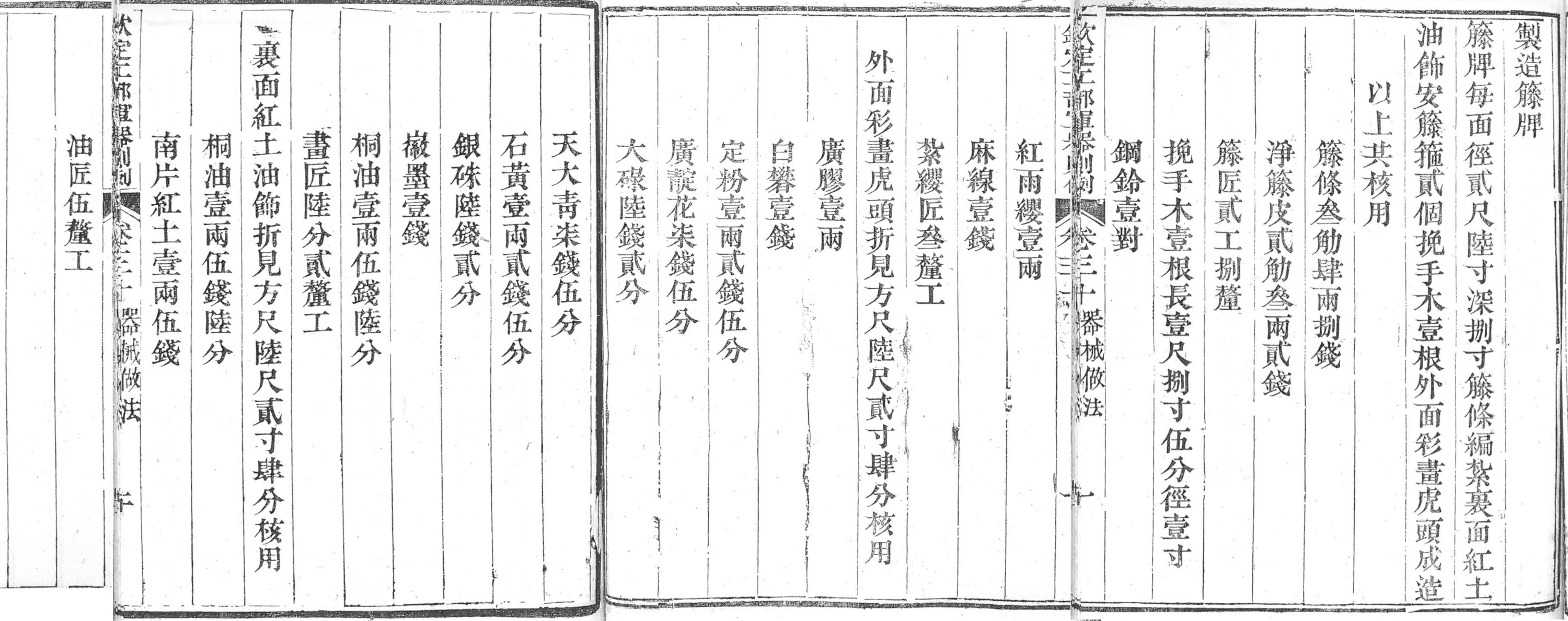 Construction of the rattan shield chapter of the Qīndìng Gōngbù Jūnqì Zélì.
Construction of the rattan shield chapter of the Qīndìng Gōngbù Jūnqì Zélì.
My translation:
藤牌每面徑貳尺陸寸深寸.
Every rattan shield diameter is 2 chi 6 cun. Depth 8 cun.
(Approx 91 cm diameter, 28 cm deep)
藤條編紮裏面紅土油飾安滕箍貳個挽手木壹根外面剁畫虎頭成造.
Made of woven rattan. The [inside] face is finished with red clay oil. Attached are two rattan hoops and one wooden handle. A color painting of a tiger head on the outside face completes the manufacture.
以上其核用
For the above is used:
藤條叁觔肆兩捌錢
Rattan cane 3 jin 4 liang 8 qian.
(Approx 1970.5 grams)
淨滕皮貳觔叁兩貳錢
Rattan skin 2 jin 3 liang 2 qian.
(Approx 1313.7 grams)
藤匠貳天工捌釐
The rattan worker spends 2 workdays 8 li on it.
(Approx 2 working days, 1 hour and 10 minutes.)
挽手木壹根長壹尺捌寸伍分徑壹寸
Wooden handle is 1 chi 8 cun 5 fen long. Diameter 1 cun.
(Approx 64.75 cm)
鋼鈐壹對
A pair of steel seals.
紅雨纓壹兩
Red rain tassel 1 liang.
(Approx 37.3 grams)
麻線壹錢
Hemp cord 1 qian.
(Approx 3.7 grams)
紮纓匠叁釐工
Tassel worker spends 3 li workday.
(Approx 26 minutes)
外面剁畫虎頭折見方尺陸尺貳寸肆分核用
Outside face color painted tiger head surface, 6 chi 2 cun 4 fen square, uses:
廣膠壹兩
Cantonese gum 1 liang. [This is gum made of the skin of bovine cattle.]
(Approx 37.3 grams)
白礬壹錢
[Potassium] alum 1 qian.
(Approx 3.7 grams)
定粉壹兩貳錢伍分
Starch 1 liang 2 qian 5 fen.
(Approx 46.6 grams)
廣靛花柒錢伍分
Indigo flower 7 qian 5 fen. [Cantonese Indigo flower.]
(Approx 28 grams)
大碌陸錢貳分
Dalu 6 qian 2 fen. [Unknown component.]
(Approx 23.1 grams)
天大靑柒錢伍分
“Heaven's great color” 7 qian 5 fen. [Probably a reddish black.]
(Approx 28 grams)
石黃壹兩貳錢伍分
Orpiment 1 liang 2 qian 5 fen.
(Approx 28 grams)
銀硃陸錢貳分
Vermillion 6 qian 2 fen.
(Approx 46.7 grams)
𡽪墨壹錢
Huizhou inkstick 1 qian.
(Approx 3.7 grams)
桐油壹兩伍錢陸分
Tung oil 1 liang 5 qian 6 fen.
(Approx 58.2 grams)
畫匠陸分貳釐工
The painter spends 6 fen 2 li workday.
(About 8 hours and 55 minutes)
裏面紅土油飾見方尺陸尺貳寸肆分核用
Inside red earth oil finish, 6 chi 2 cun 4 fen square, uses:
桐壹兩伍錢陸分
Tung oil 1 liang 5 qian 6 fen.
(Approx 58.2 grams)
南片紅土壹兩伍分
Southern red clay 1 liang 5 fen.
(Apprix 39.2 grams)
油匠伍釐工
The oiler spends 5 li workday.
Glossary
Tiān gōng (天工); "Day of work". It is unclear how many hours were considered a day of work.
Gāng qián (鋼鈐); "Steel seal". Probably metal washers that close the small hole at the center of the rattan coil that makes the shield. Some later shields have a brass boss here.
Hóng yǔ yīng (紅雨纓); "Red rain tassel". Red dyed yak hair that was used as tassels on helmets and spears as well.
Guǎng jiāo (廣膠); "Cantonese gum". A glue substance made of cattle hide.
Báifán (白礬); "Potassium alum". Used as a mordant for dyes.
Dìng fěn (定粉); "Starch". Probably used as a binder for some of the pigments.
Guǎng diàn huā (廣靛花); Cantonese Indigo flower. Used for blue dyes.
Dàlù (大碌); Unknown substance. Probably a pigment.
Tiān dà qīng (天大青); “Heaven's great color”. Qīng (青) is a word used to describe a wide array of colors. For example, it is used to describe the greenness of lush young grass, the black wool of a black sheep, the blue of a clear blue sky. In combination with tiān (天), "heaven", it is used to describe a reddish black.
Shí huáng (石黃); "Orpiment". Literally, "stone yellow". A highly toxic, orange to bright yellow arsenic sulfide mineral, commonly used as pigment up to the 19th century.
Yín zhū (銀硃); "Vermillion". A.k.a. "Chinese red" or cinnabar. A toxic mercury sulfide, or anything corresponding to that color.
Huī mò (𡽪墨); "Huizhou inkstick". Prized black Chinese ink, produced in solid form. Its main component is soot and animal glue.
Tóngyóu (桐油); "Tung oil". A prized oil used for finishing wood.
Nánpiàn hóngtǔ (南片紅土); "Southern red clay". Probably laterite, an iron and aluminum-rich clay.
Using 南片 for "southern" is a Hakka custom.
Further reading
Glossary article: Téngpái (藤牌)
Article: Making of the Chinese rattan shield
Article: Construction of the Qing dynasty long spear


